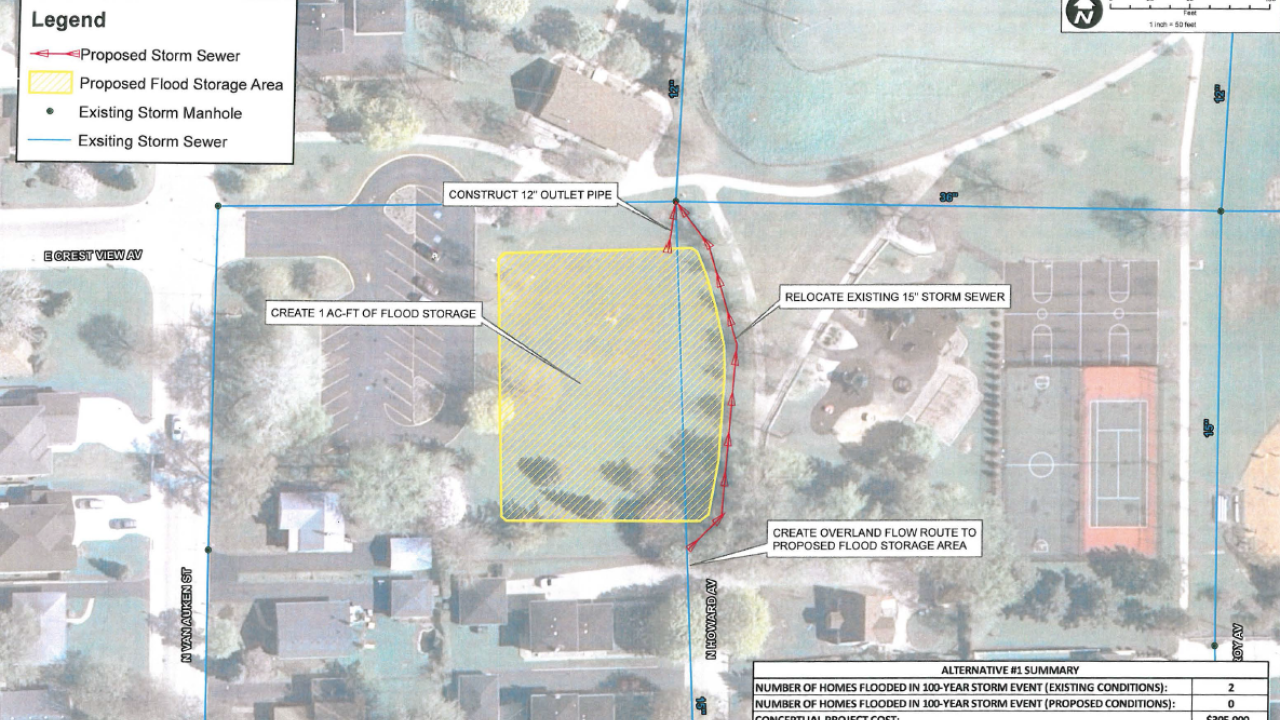Subsequent to the April 2012 Burke Report titled City of Elmhurst Comprehensive Flooding Plan - Storm Sewer System Analysis, the City requested Burke review three additional flood prone areas. This report was shared with the City Council on September 15, 2014 and then shared with the Park District. The complete report is available below in addition to conceptual drawings for Crestview Park.
February 16, 2016 Stormwater Subcommittee Update
The three remaining sites were discussed (East End, Wild Meadows Trace and Crestview) and as a response to the City’s January 13 request that the Park District forgo replacement of and compensation for these sites and instead work with the City to ask IDNR to make an exception to their policy against off-site stormwater to OSLAD funded sites, the District subcommittee shared the following statement: "At this point in time, the Park Board is not interested in encumbering additional open space with detention basins to provide relief for the approximately 11 remaining homes that would be impacted. However, as we discussed at our last meeting on January 14, the District believes that Park and City staff should discuss alternative ideas for the three sites, similar to those the City has already utilized, including the purchase of properties, storage vaults underneath parking lots and underground storage that could provide stormwater detention as well as open space and recreational opportunities at grade level." City was not receptive to the idea of considering alternative approaches to providing stormwater detention in these locations. The next subcommittee meeting will be held March 24, 2016 at 7 p.m. at City Hall. -
August 27, 2015
A draft/concept drawing for possible water storage at Crestview Park was shared by the City with the stormwater subcommittee on August 27, 2015. It is attached below.
Burke Report and Rationale Overvew
In response to the widespread overland flooding that occurred in April 2013, Burke was hired by the City of Elmhurst to study three additional flood problem areas, one of which is the Crestview Park area. The purpose of the study was to analyze the existing drainage system and identify drainage improvements that would provide a 100-year level of protection for the homes within the study area.
XP-SWMM hydrologic and hydraulic computer models were calibrated to known water surface elevations from past storm events and based on the modeling results, the existing level of flood protection was quantified for the homes within each study area. Using the calibrated models, conceptual drainage improvements were simulated to determine solutions consisting of the construction of relief sewers in conjunction with the creation of flood storage on existing open space areas adjacent to the flood-prone areas.
Concept-level cost estimates were prepared for each proposed drainage alternative, but these estimates did not include land acquisition, temporary/permanent construction easements, relocation of utilities, or the cost of recreation facilities in open space.
Burke Recommendation for Crestview Park
The Crestview Park study area included two separate flood problem areas: 1) a low-lying section of Howard Avenue adjacent to Crestview Park, and (2) the low-lying sections of Emroy Avenue, Howard Avenue, and Van Auken Avenue located immediately north of Lake Street. These flood problem areas are served by two separate drainage systems, although both systems eventually drain eastward under the Tri-State Tollway to Addison Creek.
North Study Area
The northern study area (adjacent to Crestview Park) involves an approximately 84-acre drainage area that drains to the drainage ditch through a 42-inch diameter storm sewer located at the northeast corner of the park. Flow in the drainage ditch is eventually intercepted by the storm sewer system south of Maywood Sportsmen’s Club, where it continues to flow eastward toward County Line Road. Low flows continue eastward under County Line Road and the Tri-State Tollway until they reach Addison Creek. High flows are diverted into the Arlington Cemetery reservoir, which is a pumped-evacuated facility that is dewatered after the water levels in Addison Creek have receded. There is an existing depressional area located along the northern section of Howard Avenue, immediately south of Crestview Park. The outlet for this area is an existing 15-diameter storm sewer that drains northward into the park, where it connects to a 36-inch diameter storm sewer that flows eastward until it connects to the 42-inch outlet for this drainage area. The existing 15-inch storm sewer along Howard Avenue has an approximately 2-year capacity; street ponding will occur on Howard Avenue for events equal to or greater than a 5-year return interval. Structural flooding (2 homes) will occur for storm events equal to or greater than a 100-year return interval.
South Study Area
The south study area consists of an approximately 40 acre area that drains to the 27-inch diameter storm sewer located between two properties on Emroy Avenue. This drains eastward into Elm Lawn Cemetery, where it becomes a 48-inch diameter storm sewer that flows into a detention pond located in the Elm Lawn Cemetery, which outlets to a drainage ditch through twin 24-inch diameter pipes. The drainage ditch flows northeasterly through Elm Lawn cemetery and into Arlington Cemetery, where it then becomes a 24-inch diameter pipe that outlets at County Line Road. Low flows continue eastward under County Line Road and the Tri-State Tollway until they reach Addison Creek. High flows are diverted into the Arlington Cemetery reservoir, which is a pumped-evacuated facility that is dewatered after the water levels in Addison Creek have receded.
Based on the elevations of the pipe/drainage ditch system through the cemeteries, the capacity of the storm sewer system that serves Emroy Avenue, Howard Avenue, and Van Auken Avenue is influenced by the downstream capacity of the pipe/ditch system through the cemeteries.
The existing storm sewer system has an approximately 2-year capacity, street ponding will occur in low areas for events equal to or greater than a 5-year return interval and structural flooding will occur for storm events equal to or greater than a 10-year interval.
The goal of the proposed drainage improvements is to provide a 100-year level of flood protection for the homes within each of the two flood problem areas within the study area. The proposed drainage improvements consist of utilizing flood storage created in Crestview Park in conjunction with conveyance improvements/creation of flood storage in the Elm Lawn Cemetery to mitigate the increased flow.
Alternative #1 – 100-Year Overland Flow Route/Creation of Flood Storage in Crestview Park
- Creation of 1 acre –foot of gravity-drained flood storage on the open space located in the western portion of Crestview Park.
- Regrading of park/roadway area to create an overland flow route to the proposed flood storage area.
- Relocation of 240 linear feet of 15-inch diameter storm sewer that flows northward through the park
- Installation of 30 linear feet of 12-inch diameter storm sewer that outlets the proposed flood storage area to the existing 36-inch diameter storm sewer that flows eastward through the park.
Number of Homes Protected from a 100-year Event by utilizing Crestview Park as a Detention Basin = 2 Homes. Estimated cost - $305,000
Alternative #2 – 100-Year Relief Sewer/Creation of Flood Storage in Crestview Park
This alternative provides a 100-year level of protection for 13 homes located along Van Auken Avenue, Emroy Avenue and Howard Avenue.
- Installation of 3,880 linear feet of 24-inch to 54-inch diameter relief sewer that extends from the low-lying areas of the affected street to the proposed flood storage area located at Crestview Park.
- Creation of 4 acre-feet of gravity-drained flood storage on the open space located in the western portion of Crestview Park.
- Relocation of 460 linear feet of 15-inch diameter storm sewer that flows northward through the park.
- Installation of 40 linear feet of 12-inch diameter storm sewer that outlets the proposed flood storage area to the existing 42-inch diameter storm sewer that flows eastward through the park.
Number of Homes Protected from a 100-year Event by utilizing Crestview Park as a Detention Basin = 13 Homes. Estimated cost - $3.99 Million



